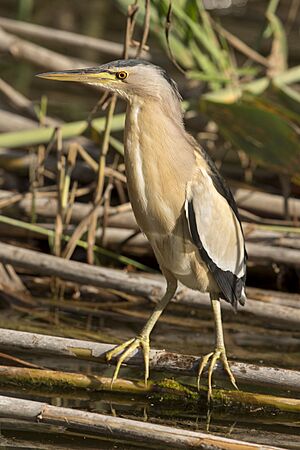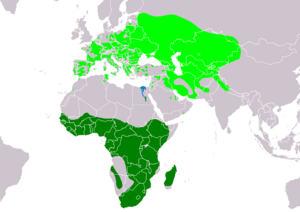Little bittern facts for kids
Quick facts for kids Little bittern |
|
|---|---|
 |
|
| A little bittern in Majorca, Spain | |
| Conservation status | |
| Scientific classification | |
 |
|
| Range of I. minutus Breeding Resident Non-breeding | |
| Synonyms | |
|
Ardea minuta Linnaeus, 1766 |
The little bittern (also called the common little bittern) is a small wading bird. It belongs to the heron family. Its scientific name is Ixobrychus minutus. The name Ixobrychus comes from ancient Greek words meaning "reed plant" and "to bellow." The word minutus is Latin for "small," which fits this tiny bird.
Contents
Where Little Bitterns Live
The little bittern lives in many parts of the Old World. They breed in Africa, central and southern Europe, and parts of Asia. You can also find them in Madagascar.
Birds from cooler areas like Europe and western Asia migrate. This means they fly south to Africa or southern Asia for winter. Bitterns that live in warmer, tropical places stay there all year. They do not migrate. It is rare to see them far north of where they usually breed.
In Britain, people have seen little bitterns breeding a few times. The first time it was officially proven was in Yorkshire in 1984. Later, in 2010, they were found breeding in the Avalon Marshes in Somerset. By 2017, they had been in that area for nine years in a row.
Different Types of Little Bitterns
The famous scientist Carl Linnaeus first described the little bittern in 1766. There are three main types, or subspecies, of the little bittern. These types look a bit different and live in different places.
- I. m. minutus: This type lives in Europe, Asia, and northern Africa. It flies to sub-Saharan Africa and southern Asia for winter.
- I. m. payesii: This type lives in sub-Saharan Africa all year round.
- I. m. podiceps: This type lives in Madagascar all year round.
Some other birds, like the Australian little bittern, used to be thought of as types of little bitterns. But now, scientists see them as their own separate species.
What Little Bitterns Look Like
The little bittern is about 33 to 38 centimeters (13 to 15 inches) long. Its wings can spread out to 52 to 58 centimeters (20 to 23 inches). It is the smallest heron that breeds in Europe. You can spot it by its small size, long, sharp beak, and thick neck.
Male little bitterns have a special look. Their head, back, and tail are black with a slight green shine. Their belly is a pale, light brown color. On their wings, they have a pinkish-brown oval patch. This patch stands out against their black wings. The underside of their wings is white.
Female little bitterns are not as bright as the males. Their upper parts are brownish-black. Their belly is streaked with dark brown and light brown. The wing patch on females is not as clear as on males.
Young little bitterns (juveniles) are duller and more reddish-brown than females. They have more streaks on their upper parts and belly.
Little Bittern Population Status
Little bitterns used to be common in Central Europe. Now, they are found in fewer places, mostly in lowlands. They can be found from Europe (but not regularly in Great Britain or Scandinavia) to West Siberia. They also live in North Africa, southern Iran, and south of the Sahara Desert in Africa. Some groups also live in Madagascar and Australia.
There are about 60,000 to 120,000 breeding pairs in Europe. Many of these are in Russia, Ukraine, Romania, and Turkey. In Central Europe, there are about 5,300 to 7,800 pairs, with most in Hungary. The number of little bitterns in Germany has gone down to just over 100 breeding pairs. It is hard to count these birds because they are very shy and secretive.
The little bittern is a bird protected by the Agreement on the Conservation of African-Eurasian Migratory Waterbirds. This agreement helps protect birds that fly long distances between Africa and Europe/Asia.
Little Bittern Behaviour and Life Cycle
Little bitterns are most active around dawn and dusk. They are usually shy and live alone. They eat fish, frogs, and insects. They catch their food by slowly walking through reeds or along the water's edge.
In spring, the male bittern finds a place to live. He makes a deep barking or croaking sound to show he is there. The male and female usually stay together for at least one breeding season.
Reproduction
They build their nests in thick reeds, rushes, or bushes above the water. From mid-May, the female lays about 5 to 6 eggs. The parents take turns sitting on the eggs for 17 to 19 days until they hatch. The young birds are ready to fly after 25 to 30 days.
Migration
In Europe, little bitterns are migratory birds. They fly across the Mediterranean Sea from Africa in early spring. They arrive at their breeding wetlands around mid-April. They fly back to Africa in August and September. By October, usually only a few young birds are left in Europe. The birds that breed in Europe fly as far south as the Eastern Cape and Transvaal in Africa.
Images for kids




